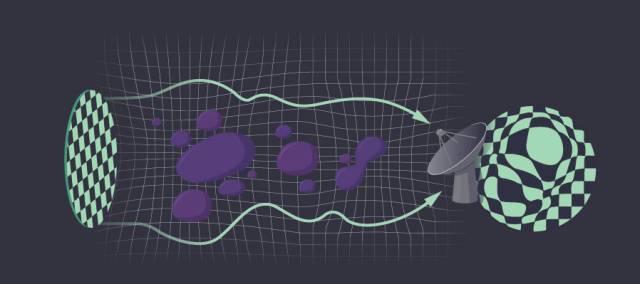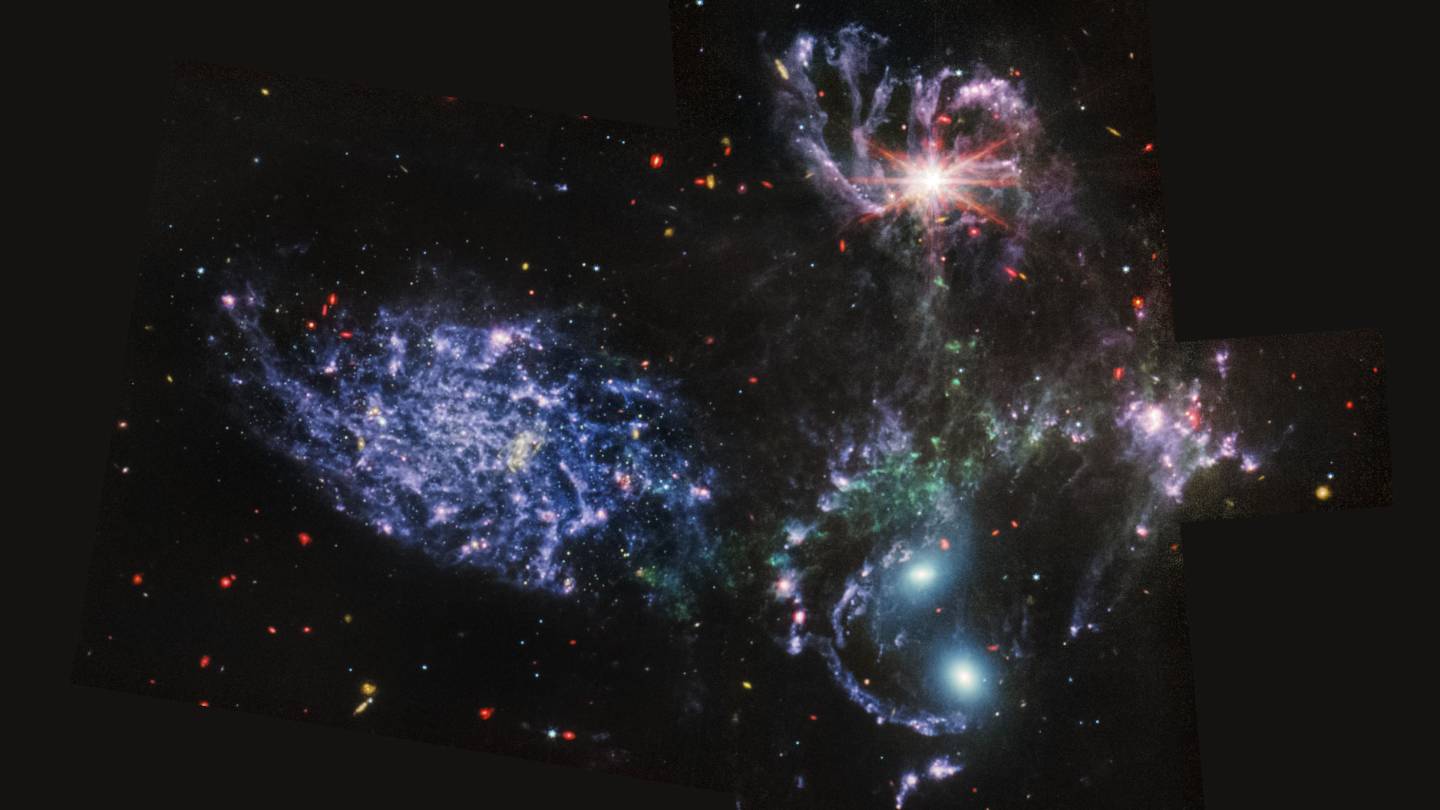Cosmic growth: unlike ancient philosophers imagining the universe’s origins, modern cosmologists use quantitative tools to gain insights into its evolution and structure. Modern cosmology dates back to the early 20th century, with the development of Albert Einstein’s theory of general relativity.
The cosmic microwave background (CMB) radiation, ancient light emitted when the universe was in its infancy, has travelled billions of years, witnessing the formation of stars, galaxies and galaxy clusters. These massive objects’ gravitational fields have influenced CMB light’s path. At the left is the Big Bang; the wavy lines illustrate the distortion caused by the dark matter and regular matter of galaxies; at the right is an image of the warped light received by the Atacama Cosmological Telescope (ACT). At the lower left is the new map of the dark matter made by the ACT team, a visualization of all the matter in the path of the CMB light. The orange regions show where there is more mass; purple where there is less. Illustration by Lucy Reading-Ikkanda / Simons Foundation and the ACT Collaboration
Now, researchers from the Atacama Cosmology Telescope (ACT) collaboration have submitted a set of papers to The Astrophysical Journal featuring a groundbreaking new map of dark matter distributed across a quarter of the sky, extending deep into the cosmos, that confirms Einstein’s theory of how massive structures grow and bend light over the 14-billion-year life span of the universe.
The new cosmic map uses light from the cosmic microwave background (CMB) as a backlight to silhouette all the matter between us and the Big Bang.
“It’s a bit like silhouetting, but instead of just having black in the silhouette, you have texture and lumps of dark matter, as if the light were streaming through a fabric curtain that had lots of knots and bumps in it,” said Suzanne Staggs, director of ACT and Henry DeWolf Smyth Professor of Physics at Princeton University.
“The famous blue and yellow CMB image [from 2003] is a snapshot of what the universe was like in a single epoch, about 13 billion years ago, and now this is giving us the information about all the epochs since.”

To see invisible dark matter, the research team look at how its gravity bends light, just ancient windows of uneven thickness stretch and bend what appears behind them. Here, a simple checkerboard pattern (left) is warped by the purple blobs before the image is picked up by the Atacama Cosmology Telescope (right), resulting in the distorted view at the right. Astronomers look for these distortion patterns in distant light to map the distributions of dark matter. Image by Lucy Reading-Ikkanda / Simons Foundation
“It’s a thrill to be able to see the invisible, to uncover this scaffold of dark matter that holds our visible star-filled galaxies,” said Jo Dunkley, a professor of physics and astrophysical sciences, who leads the analysis for ACT. “In this new image, we can see directly the invisible cosmic web of dark matter that surrounds and connects galaxies.”
“Usually, astronomers can only measure light, so we see how galaxies are distributed across the universe; these observations reveal the distribution of mass, so primarily show how the dark matter is distributed through our universe,” said David Spergel, Princeton’s Charles A. Young Professor of Astronomy on the Class of 1897 Foundation, Emeritus, and the president of the Simons Foundation.

A view of Stephan’s Quintet, a visual grouping of five galaxies from the James Webb Telescope. Image courtesy of NASA, ESA, CSA, STScI
“We have mapped the invisible dark matter distribution across the sky, and it is just as our theories predict,” said co-author Blake Sherwin, a 2013 Ph.D. alumnus of Princeton and a professor of cosmology at the University of Cambridge, where he leads a large group of ACT researchers.
“This is stunning evidence that we understand the story of how structure in our universe formed over billions of years, from just after the Big Bang to today.’
He added: “Remarkably, 80% of the mass in the universe is invisible. By mapping the dark matter distribution across the sky to the largest distances, our ACT lensing measurements allow us to clearly see this invisible world.”
“When we proposed this experiment in 2003, we had no idea the full extent of information that could be extracted from our telescope,” said Mark Devlin, the Reese Flower Professor of Astronomy at the University of Pennsylvania and the deputy director of ACT, who was a Princeton postdoc from 1994-1995.
“We owe this to the cleverness of the theorists, the many people who built new instruments to make our telescope more sensitive, and the new analysis techniques our team came up with.” This includes a sophisticated new ACT instrument noise model by Princeton graduate student Zach Atkins.
Despite making up most of the universe, dark matter has been hard to detect because it doesn’t interact with light or other forms of electromagnetic radiation. As far as we know, dark matter only interacts with gravity.
To track it down, the more than 160 collaborators who have built and gathered data from the National Science Foundation’s Atacama Cosmology Telescope in the high Chilean Andes observed light emanating following the cosmic dawn of the universe’s formation, the Big Bang — when the universe was only 380,000 years old. Cosmologists often refer to this diffuse CMB light that fills our entire universe as the “baby picture of the universe.”
The team tracked how the gravitational pull of massive dark matter structures can warp the CMB on its 14-billion-year journey to us, just as antique, lumpy windows bend and distort what we can see through them.
“We’ve made a new mass map using distortions of light left over from the Big Bang,” said Mathew Madhavacheril, a 2016-2018 Princeton postdoc who is the lead author of one of the papers and an assistant professor in physics and astronomy at the University of Pennsylvania.
“Remarkably, it provides measurements that show that both the ‘lumpiness’ of the universe, and the rate at which it is growing after 14 billion years of evolution, are just what you’d expect from our standard model of cosmology based on Einstein’s theory of gravity.”
Sherwin added, “Our results also provide new insights into an ongoing debate some have called ‘The Crisis in Cosmology.’”
This cosmic “crisis” stems from recent measurements that use a different background light emitted from stars in galaxies rather than the CMB. These have produced results that suggest the dark matter was not lumpy enough under the standard model of cosmology and led to concerns that the model may be broken. However, the ACT team’s latest results precisely assessed that the vast lumps in this image are the right size.
“While earlier studies pointed to cracks in the standard cosmological model, our findings provide new reassurance that our fundamental theory of the universe holds true,” said Frank Qu, lead author of one of the papers and a Cambridge graduate student as well as a former Princeton visiting researcher.
“The CMB is famous already for its unparalleled measurements of the primordial state of the universe, so these lensing maps, describing its subsequent evolution, are almost an embarrassment of riches,” said Staggs, whose team built the detectors that gathered this data over the past five years.
“We now have a second, very primordial map of the universe. Instead of a ‘crisis,’ I think we have an extraordinary opportunity to use these different data sets together. Our map includes all of the dark matter, going back to the Big Bang, and the other maps are looking back about 9 billion years, giving us a layer that is much closer to us. We can compare the two to learn about the growth of structures in the universe. I think is going to turn out to be really interesting. That the two approaches are getting different measurements is fascinating.”
ACT, which operated for 15 years, was decommissioned in September 2022. Nevertheless, more papers presenting results from the final set of observations are expected to be submitted soon, and the Simons Observatory will conduct future cosmic observations at the same site, with a new telescope slated to begin operations in 2024. This new instrument will be capable of mapping the sky almost 10 times faster than ACT.
Of the co-authors on the ACT team’s series of papers, 56 are or have been Princeton researchers. More than 20 scientists who were junior researchers on ACT while at Princeton are now faculty or staff scientists themselves. Lyman Page, Princeton’s James S. McDonnell Distinguished University Professor in Physics, was the former principal investigator of ACT.
Written by Liz Fuller-Wright
Source: Princeton University

